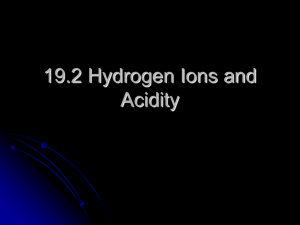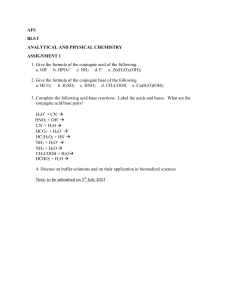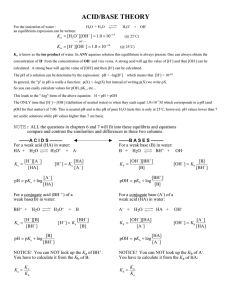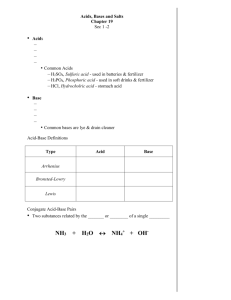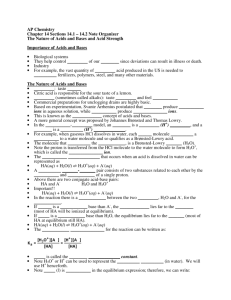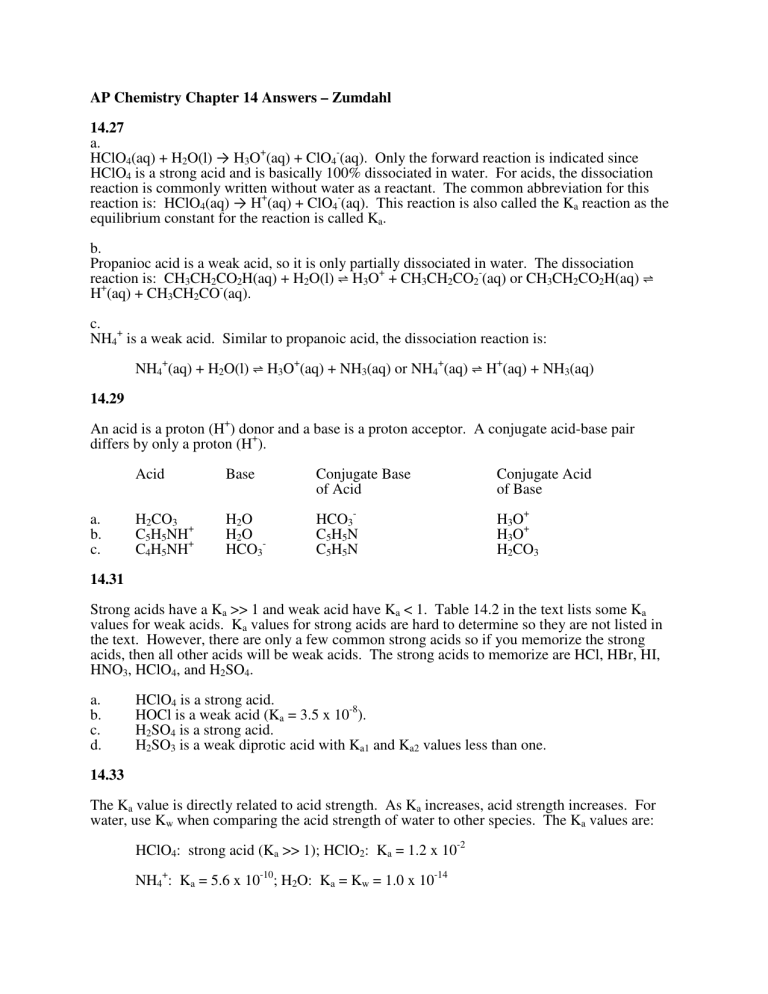
AP Chemistry Chapter 14 Answers – Zumdahl 14.27 a. HClO4(aq) + H2O(l) → H3O+(aq) + ClO4-(aq). Only the forward reaction is indicated since HClO4 is a strong acid and is basically 100% dissociated in water. For acids, the dissociation reaction is commonly written without water as a reactant. The common abbreviation for this reaction is: HClO4(aq) → H+(aq) + ClO4-(aq). This reaction is also called the Ka reaction as the equilibrium constant for the reaction is called Ka. b. Propanioc acid is a weak acid, so it is only partially dissociated in water. The dissociation reaction is: CH3CH2CO2H(aq) + H2O(l) ⇌ H3O+ + CH3CH2CO2-(aq) or CH3CH2CO2H(aq) ⇌ H+(aq) + CH3CH2CO-(aq). c. NH4+ is a weak acid. Similar to propanoic acid, the dissociation reaction is: NH4+(aq) + H2O(l) ⇌ H3O+(aq) + NH3(aq) or NH4+(aq) ⇌ H+(aq) + NH3(aq) 14.29 An acid is a proton (H+) donor and a base is a proton acceptor. A conjugate acid-base pair differs by only a proton (H+). a. b. c. Acid Base Conjugate Base of Acid Conjugate Acid of Base H2CO3 C5H5NH+ C4H5NH+ H2O H2O HCO3- HCO3C5H5N C5H5N H3O+ H3O+ H2CO3 14.31 Strong acids have a Ka >> 1 and weak acid have Ka < 1. Table 14.2 in the text lists some Ka values for weak acids. Ka values for strong acids are hard to determine so they are not listed in the text. However, there are only a few common strong acids so if you memorize the strong acids, then all other acids will be weak acids. The strong acids to memorize are HCl, HBr, HI, HNO3, HClO4, and H2SO4. a. b. c. d. HClO4 is a strong acid. HOCl is a weak acid (Ka = 3.5 x 10-8). H2SO4 is a strong acid. H2SO3 is a weak diprotic acid with Ka1 and Ka2 values less than one. 14.33 The Ka value is directly related to acid strength. As Ka increases, acid strength increases. For water, use Kw when comparing the acid strength of water to other species. The Ka values are: HClO4: strong acid (Ka >> 1); HClO2: Ka = 1.2 x 10-2 NH4+: Ka = 5.6 x 10-10; H2O: Ka = Kw = 1.0 x 10-14 From the Ka values, the ordering is: HClO4 > HClO2 > NH4+ > H2O. 14.35 a. HCl is a strong acid and water is a very weak acid with Ka = Kw = 1.0 x 10-14. HCl is a much stronger acid than H2O. b. H2O, Ka = Kw = 1.0 x 10-14; HNO2, Ka = 4.0 x 10-4; HNO2 is a stronger acid than H2O because Ka for HNO2 > Kw for H2O. c. HOC6H5, Ka = 1.6 x 10-10; HCN, Ka = 6.2 x 10-10; HCN is a stronger acid than HOC6H5 because Ka for HCN > Ka for HOC6H5. 14.37 At 25oC, the relationship: [H+][OH-] = Kw = 1.0 x 10-14 always holds for aqueous solutions. When [H+] is greater than 1.0 x 10-7 M, the solution is acidic; when [H+] is less than 1.0 x 10-7 M, the solution is basic; when [H+] = 1.0 x 10-7 M, the solution is neutral. In terms of [OH-], an acidic solution has [OH-] < 1.0 x 10-7, a basic solution has [OH-] > 1.0 x 10-7 M, and a neutral solution has [OH-] = 1.0 x 10-7. a. [OH-] = Kw / [H+] = 1.0 x 10-14 / 1.0 x 10-7 = 1.0 x 10-7 M; The solution is neutral. b. [OH-] = 1.0 x 10-14 / 8.3 x 10-16 = 12 M; The solution is basic. c. [OH-] = 1.0 x 10-14 / 12 = 8.3 x 10-16 M; The solution is acidic. d. [OH-] = 1.0 x 10-14 / 5.4 x 10-5 = 1.9 x 10-10 M; The solution is acidic. 14.39 a. Because the value of the equilibrium constant increases as the temperature increases, the reaction is endothermic. In endothermic reactions, heat is a reactant so an increase in temperature (heat) shifts the reaction to produce more products and increases K in the process. b. H2O(l) ⇌ H+(aq) + OH-(aq) Kw = 5.47 x 10-14 = [H+][OH-] at 50.oC In pure water [H+] = [OH-], so 5.47 x 10-14 = [H+]2, [H+] = 2.34 x 10-7 M = [OH-]
